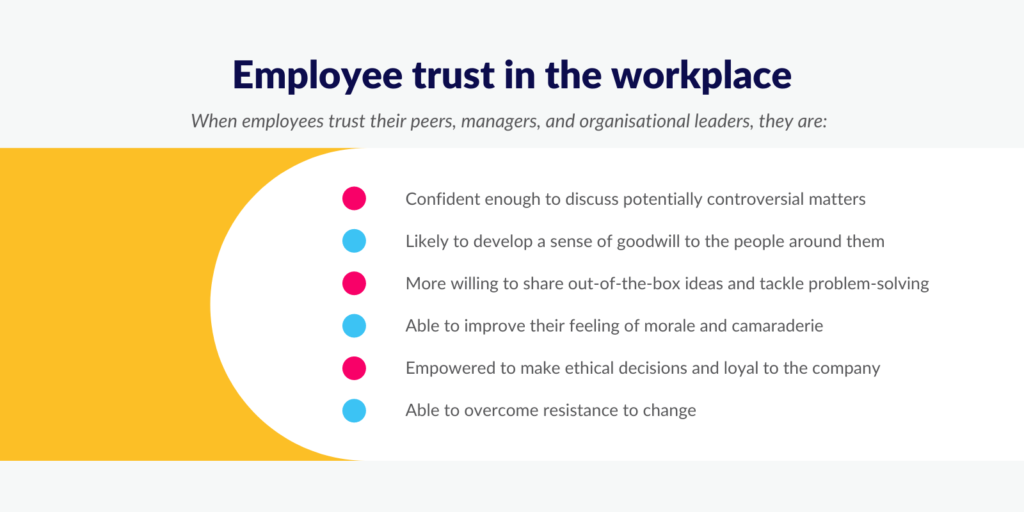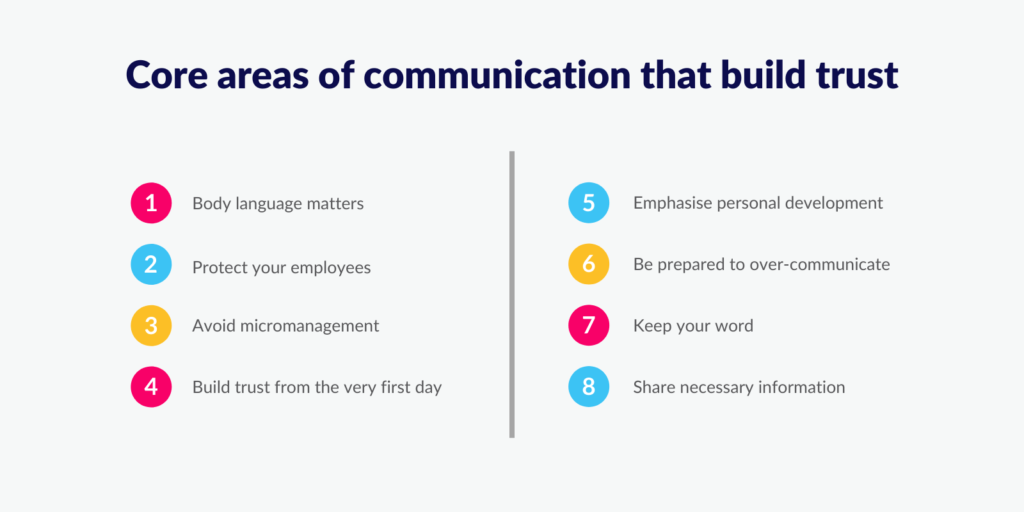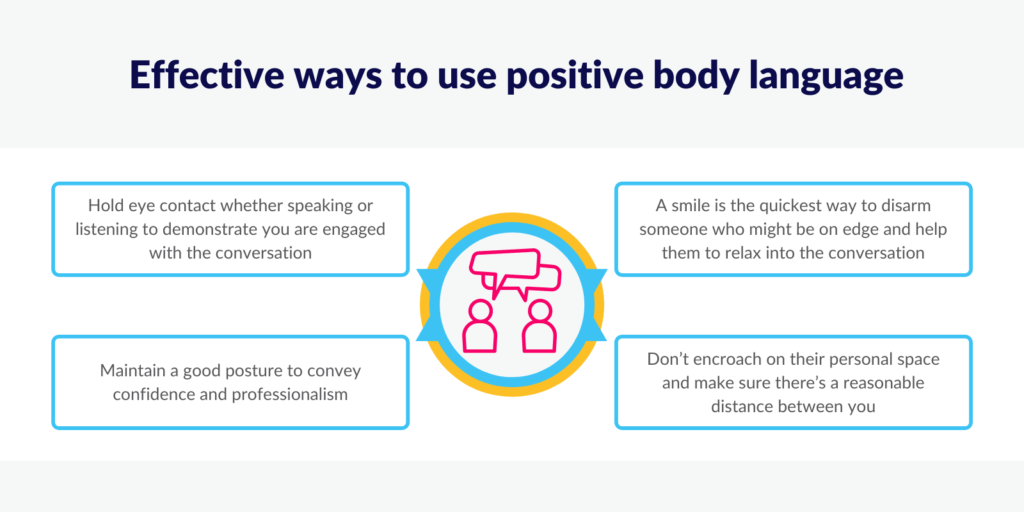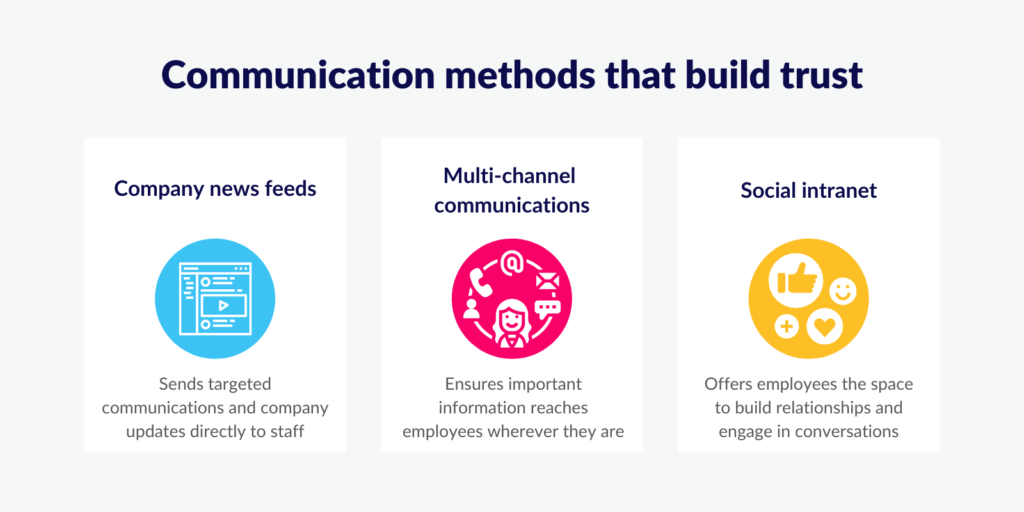Building trust in the workplace gives employees the confidence to speak openly and take on board constructive criticism. It also improves employee engagement while motivating their professional development.
This article will explore how you can start building trust in the workplace, from mastering body language and avoiding micromanagement, to putting the right systems in place to encourage open communication.
Why does trust matter in the workplace?
Individuals and teams deliver the best results when they know they can trust their colleagues – and the company at large – to support their work. Mutual trust gives staff the confidence to work effectively and productively, offering a psychological safety net that allows them to recover from failure and learn from their mistakes.
An article from Forbes magazine discussing the importance of workplace trust cites Timothy R. Clark, CEO of LeaderFactor, on how trust helps build this sense of safety in teams.
“The link between trust and psychological safety is based on my prediction of your behavior based on your pattern of behavior. If I can predict that you won’t embarrass, punish, or humiliate me when I’m interacting with you and others in a social setting, I’m much more likely to engage, participate, and release my discretionary efforts.”

When employees trust their peers, managers, and organisational leaders, they:
- Feel confident they can ask probing questions and discuss potentially controversial matters.
- Develop a sense of goodwill to the people around them, becoming more willing to share out-of-the-box ideas and tackle problem-solving with confidence.
- Improve their feeling of morale and camaraderie, developing a greater sense of kinship which leads to more effective collaboration and teamwork.
- Become empowered to make ethical decisions and loyal to the company.
- Overcome resistance to change, with a positive breakdown of corporate silos opening people up to persuasive ideas which they share with enthusiasm.
Let’s take a closer look at the steps you can take to help encourage employees and develop a positive work environment where productivity, employee feedback, and communication flourish.
Start building trust with your employees
There is a range of core areas of communication that can be focused on to develop and strengthen levels of trust throughout the workforce. Each of these should be applied in tandem with one another and as consistently as possible, both for individuals, teams, and departments.

Body language matters
The way we express ourselves is more than the words we say. It’s also deeply rooted in our body language, and being mindful of the role body language plays in communication can help build trust before anything has been said.

Some effective ways to use positive body language to build trust include:
- Hold eye contact whether speaking or listening to demonstrate you are engaged with the conversation
- Maintain a good posture to convey confidence and professionalism. Avoid slouching and keep your arms in an open position
- Smile whenever appropriate. A smile is the quickest way to disarm someone who might be on edge and help them to relax into the conversation and feel at ease
- Don’t encroach on their personal space and make sure there’s a reasonable distance between you and the other person. Getting up close and personal can be intimidating

Protect your employees
When a crisis looms for an employee, they need to know the company will be there to offer support and understanding. Employees who know the company will have their back in an emergency will trust their team leaders and managers, and relationship building will be strengthened.
To help employees understand the company will protect them when it matters, make it clear the support they can expect to receive in the company handbook. When employees are being onboarded, be explicit and tell them their managers and HR department are available to answer any questions they have.
Avoid micromanagement
The negative consequences of micromanagement have long been understood in the business community. Micromanagement removes the individual’s sense of agency over their work, establishing a tone of mistrust in their capabilities.
As such, it should be avoided whenever possible, especially if you’re a manager or team leader who often finds yourself frustrated with how others go about their work.
Muriel Maignan Wilkins’s article for the Harvard Business Review, Signs That You’re A Micromanager, offers a series of solutions to help leaders avoid micromanagement. She states:
“Your job as a manager is to clearly set the conditions of satisfaction for any task you assign. Articulate what you envision the final outcome to look like, but don’t give blow-by-blow instructions on how to get there. When in doubt, share the “what” and ask (rather than tell) your team member about how they plan to get there. You might be surprised that their approach, while different, may yield excellent results.”
Key performance indicators can be an effective tool for putting this principle into practice and allowing employees to control their own tasks. Furthermore, these goals can be used to help improve employee engagement while fostering relationships and strengthening the trust which has been undermined through micromanagement.
Build trust from the very first day
Trust and a foundation of open communication should be understood as core values of the company the moment a new hire starts their first day. This mutual respect can be achieved by how their direct report presents themselves, and the initial conversations which set the tone for the new relationships they will have with their teammates.
Emphasising the importance of personal development
An effective way to deliver a strong message to new starters about trust is to start off with a conversation about their personal development. This lets them know that they aren’t just another cog in the corporate machine, but rather someone who is valued for the breadth of skills they can bring to the table, now and in the future.
Make sure the drafting of a Personal Development Plan (PDP) is high on the onboarding agenda, with the manager involved in putting this together making sure they take an active interest in the new starter’s ambitions. Once the PDP has been created, connect the new employee with the people and resources best suited to help them accomplish their goals.
Be prepared to over-communicate
A lack of communication is one of the leading causes of lack of trust in relationships, whether they’re professional or personal. If you want trust to thrive in the workplace, you should be prepared to over-communicate and be as forthright as possible.
Saying too much is nearly always better than leaving things unspoken, and trust is more firmly established when ideas are clearly expressed and discussed openly.
The article from the World Economic Forum, Why You Need to Over-Communicate, sums up the importance of over-communication, stating:
“No matter your role in your company, you can never over-communicate. You may think you sound like a broken record but that’ll be the farthest from the truth. Keep repeating yourself until you can barely stand to hear yourself anymore. Then, keep repeating yourself!”
Keep your word
Keeping your word is a fundamental part of establishing and maintaining trust in the workplace. While this may seem like an obvious point to make – after all, most people try their best to be good to their word – it can be easy to fail in this respect simply through forgetfulness or being distracted by other matters.
If you make promises to co-workers, make a note – either mental or in a scheduler – so you know to follow up on this at an appropriate time. If you’re unable to keep your word, then raise this with the person at hand and explain why you’re no longer in a position to do what you said.
Likewise, if you’re not in a position to do something because you lack either the know-how or the time, be upfront and honest about this. Don’t give your word knowing you won’t be able to keep it, since this will inevitably create problems for you down the line.
Share necessary information
Employees who feel out of the loop on important topics and conversations are far more likely to mistrust the organisation they work for. Putting in place a solid communications foundation with a variety of touchpoints is a great way to avoid isolating individuals and getting them involved in conversations, improving their overall job satisfaction.

Some approaches to communication that you can use to help build trust in the workplace include:
Multi-channel communications
With employees often located in different office spaces, as well as working remotely, using a multi-channel communications platform is crucial for keeping everyone connected.
Capable of delivering information across multiple platforms including desktop/laptop computers and mobile devices, a multi-channel system ensures important information reaches the relevant people wherever they are. Building trust means keeping people in the loop, and a multi-channel communications platform offers dedicated tools to get the job done.
Company news feeds
With emails often unreliable, a company news feed helps business leaders send targeted communications and company updates directly to staff. Combined with a multi-channel communications system, this makes sure employees are always up to speed on the latest developments.
Social intranet
The ability to collaborate with colleagues is a key component of trust, and social intranets offer employees the space to build relationships and engage in productive conversations. Social intranet groups and chats can be tied to custom social feeds, helping to build trust through continuous engagement.
Summary
Trust is the foundation of any successful relationship, and this is as important in the workplace as it is in our personal lives. This guide should help you to strengthen trust between leaders and employees through a range of easy-to-implement strategies.
By making the most of your communications platform to reinforce the values that matter the most, you can encourage personal development through constructive criticism and help develop strong bonds with your employees.





